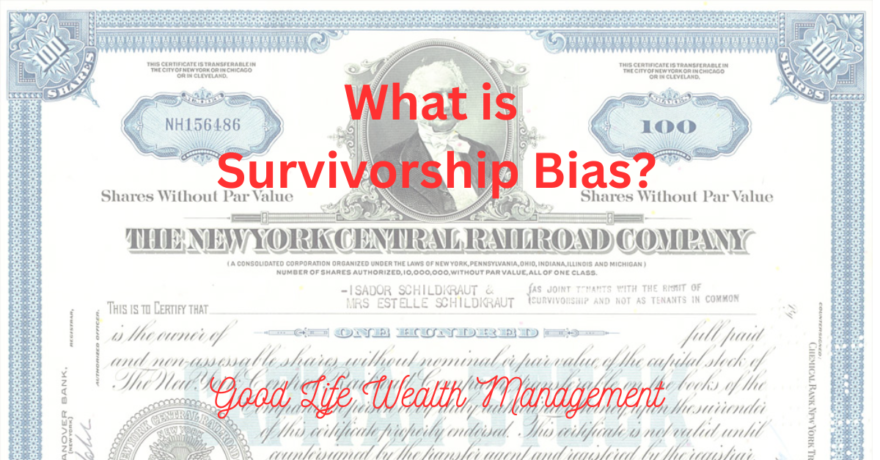Survivorship bias is the problem that the track record of today’s stocks reflects only the ones that survived. The stocks and funds which failed are no longer part of the performance history of today’s stocks or mutual fund databases. And as we will see, over the years, there have been a lot of stocks that have had bad returns and disappeared. We will also discuss how to invest wisely given the reality of survivorship bias.
Growing up in Rochester NY, my neighbor on the left worked for Eastman Kodak. Our neighbor on the right worked for Kodak. And all three neighbors across the street worked for Kodak. Kodak Park was the largest industrial site in the world, stretching for miles along Ridge Road. Rochester was a company town and there was tremendous pride in Kodak. The stock had done well for employees and residents, the company contributed a lot to the community, and the pension plan provided security to tens of thousands of retirees.
Kodak, the stock, was part of the S&P 500 Index and was one of 30 components of the Dow Jones Industrial Average from 1930 until April 2004. The company actually invented the digital camera in 1975, but thought it would be too impractical to ever have value. The rest, as they say, is history. The company had a long decline into obsolescence and filed for bankruptcy in 2012. The once mighty stock went to zero.
Stock Market 1926 through 2023
A new research paper by Hendrik Bessembinder looks at US stocks from 1926 through 2023, a 98-year period. During this period, there were a total of 29,078 US-listed stocks. Today, there are around 5,000. He looked at the performance of these stocks and it is a remarkable picture of Survivorship Bias.
- Only 31 stocks have been in existence for the entire 98 years. The average stock existed only for 11.6 years. Approximately 24,000 companies have disappeared: either bankrupt, merged, acquired, or taken private.
- 51 percent of the stocks had negative returns over their entire life, with a median compound cumulative return of -7.41%. Most stocks lost money!
- Thankfully, the compounding effect of the winning stocks greatly offset the stocks which lost money. The mean performance is much better than the median performance of the 29,078 stocks.
- If you randomly select 10 stocks from history, your chance of outperforming the S&P 500 is very small. That is because most of the wealth creation in the market comes from a small percentage of top-performing companies. The majority of stocks under-perform the index.
Idiosyncratic Risk
Eastman Kodak, Lehman Brothers, Enron, and General Motors all went bankrupt and their stocks went to zero. Even though the stock market has done well over the long-term, there are still many individual stocks that get destroyed. We call this Idiosyncratic Risk, or “company specific” risk. Unfortunately, even if you do your homework, investors risk being caught in the next Bear Stearns or Washington Mutual.
What can you do to address Survivorship Bias and reduce the Idiosyncratic Risk of individual stocks?
- Diversify extensively with index funds. While single companies do go bankrupt, we have never seen all 500 companies of the S&P 500 index go bankrupt at once. An index fund can greatly spread out your risk. Recognize the difference between speculating on an individual company versus investing in the market as a whole.
- Note that index funds are not static. Every year, the S&P 500 Index adds growing companies and drops other companies which are on their way down. Sure, there are still surprises where an S&P 500 company disappears suddenly (like Silicon Valley Bank last year), but you still have 499 other holdings.
Fund Shenanigans
It’s not just individual stocks that exhibit survivorship bias. Mutual Fund companies do the same thing, deliberately getting rid of their worst funds. A fund with a poor track record eventually gets so small that it is unprofitable, and the fund company shuts it down. Even more nefarious, companies create dozens of stock funds and then take the ones with a poor track record and roll them into their funds with better ratings. The crappy fund disappears and now it looks like all their funds are 4-star and 5-star funds!
You might think the solution is to avoid the mutual funds with a poor track record and go with a top ranked actively managed fund. Unfortunately, we know that performance is rarely consistent with actively managed mutual funds. Is that my opinion? No, this is what decades of data shows from the Standard and Poors Persistence Scorecard. For example, there were more than 2000 US stock mutual funds in December 2019. The top quartile (the top 25%) included 529 funds in 2019, but not a single one of those funds remained in the top quartile over the next four years, through December 2023. Past performance (you should know this by heart by now) is no guarantee of future results.
One of the consistent findings of the S&P Persistence Scorecard is that the worst performing funds are the most likely to merge or be shut down. And then you can’t find those one-star funds on Morningstar because they no longer exist. That’s survivorship bias. Our approach: use low-cost index funds from Vanguard, SPDRs, and others. Then we are not chasing performance, looking for the hot fund, sector, or country. And we have been saying for a long time: the vast majority of active managers under-perform their benchmark over time.
Keeping It Simple
The stocks which exist today are different from the ones from 98 years ago. Companies come and go. Survivorship Bias masks the poor track record of the many stocks and funds which have disappeared. When we only see the ones which survived and thrived, investing success looks easier and more inevitable than it really is. Unfortunately, there are stocks and funds out there today which will someday suffer the same fate as Eastman Kodak and thousands of other past stocks. Understanding this history will help you be a better investor in the decades ahead.
How can we reduce Idiosyncratic Risk or Survivorship Bias? Fortunately for investors, this complex question has a simple answer. We can diversify and reduce the importance of any one stock in our portfolio. With index funds, we get broad diversification, with hundreds or thousands of holdings, in a low-cost, tax-efficient vehicle. No doubt an index fund will own some stocks that fail, but one stock out of 500 may only move the index by 0.2% for one day. It often is hardly even noticed. And using index funds also helps keep us out of the worst actively managed funds, which sometimes were the best funds from five years ago. These are time tested strategies and the data keeps proving that this approach remains a wise choice for investors.













